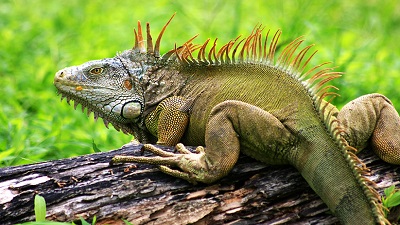Taxonomy
Kingdom |
Phylum |
Class |
Order |
Family |
Genus |
Species |
| Animalia | Chordata | Reptilia | Squamata | Iguanidae | Iguana | Iguana Iguana |
0

Green iguana from the Amazon Rainforest.
0
Name
- Scientific name: Iguana iguana
- Common name: Green iguana, common iguana.
Habitat and Distribution
- The green iguana is a species of lizard native to the tropical rainforests of South America and Central America.
- Its native range is from southern Mexico to Central Brazil.
- Introduced by men, today they are found in South Florida, Hawaii, Rio Grande Valley in Texas, Grand Cayman, Puerto Rico and other Caribbean islands.
- Their habitat is the forest canopy near sources of water. Adult green iguanas spend most of their time basking high in the forest canopy. Juvenile green iguanas live lower in the canopy.
- Green iguanas adapt well. They are considered an invasive species in some non native habitats. They have adapted and expanded over territory of other native iguana species such as the Lesser Antillean iguana (Iguana delicatissima) which is a threatened species in the IUCN Red List.
Physical Features
- Despite their name they come in different colors. Females are predominantly green. Male coloration depends on mood, temperature and social status.
- Juvenile green iguanas are bright green. As they grow older they change colors.
- In the morning when their body temperature is low their skin color is darker to absorb more heat. In the afternoon these animals become lighter to minimize heat absortion.
- Its skin is very thick and tough and its color helps them blend with their surroundings working as a camouflage to remain undetected from predators.
- Their tails have black stripes and are used as weapons. If it breaks it re grows a new one within a year.
- Green iguanas have a photosensory organ on top of their heads called parietal eye or third eye. It does not work as an eye to capture images but it captures changes in light and therefore motion.
- Under their throat they have a hanging dewlap which is more developed in adult males than females.
- Its torso is made up of a crest of spines that run from the mid neck to the base of the tail.
- They have long fingers and claws to climb trees.
Behavior
- Green iguanas are diurnal and arboreal, they are found basking high in the canopy near sources of water. Scientists believe this is a safety measure against predators since they can fall into the water and swim away.
- They are agile climbers and swimmers.
- They spend a lot of time basking in the sun to regulate their body temperature.
- Six to eight weeks after courtship males change color to orange or gold.
- Dominant iguanas have darker color skin.
- Males are territorial they will mark their territory with scent glands. They will be aggressive against another iguana when defending their basking site. They also show aggressive behavior during mating season.
- When an iguana is frightened it will freeze or hide.
- They use body language to communicate with rivals, such as dewlap extension and head bobbing.
Diet
- Green iguanas are strictly herbivorous; their diet is based on leafy plants and ripe fruit.
Reproduction
- They reach reproductive maturity from 3 to 4 years of age.
- Green iguanas are polygynandrous, males and females will have multiple mates.
- They breed during the dry season. Green iguanas are oviparous, females lay eggs 65 days after mating.
- It takes a female green iguana three days to lay a clutch of 10 to 30 eggs.
- They build their nests 17.7 in to 39 in or 45 cm to 1 m deep and may be shared with other females.
- Incubation lasts 90 to 120 days. Their young are born during rainy season when food is abundant.
- Baby green iguanas are born 6.7 to 9.8 in or 17 to 25 cm long. They are independent from birth and stay in groups during their first year.
Life Expectancy
- They live an average of 8 years in the wild and 20 years in captivity.
Threats
- Green iguanas are popular pets in the U.S., Europe and Japan.
- Iguanas are consumed in South and Central America, it is a source of protein for poor people.
- Large birds and hawks are their natural predator.
- Loss of habitat due to logging and urban development.
Conservation Status
- The IUCN has not assessed the green iguana in its Red List of Threatened Species as it is abundant and not endangered. Other species of iguanas are threatened.
Did you know?
In Central and South America green iguanas are known as gallina de palo or chicken of the tree because it is said it tastes like chicken.
References and further research
World Association of Zoos and Aquariums – Green Iguana
The invasive Green Iguana (Iguana iguana) – Caribbean invasive species
Husbandry Manual for the green iguana – Western Sydney Institute of TAFE